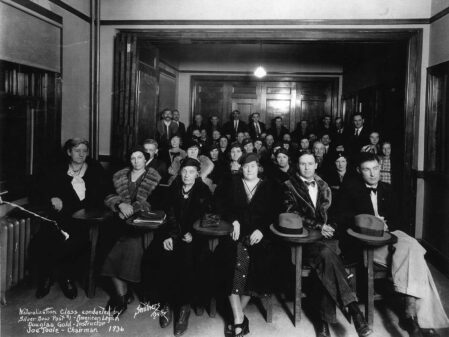
The Contributions of Immigrants to the Heritage and Traditions of Montana and the West
By Aubrey Jaap, Director, Butte-Silver Bow Public Archives
From the anonymous saying: “If you are more fortunate than others, it is better to build a longer table than a taller fence.”
Long before the first Euro-American settlers arrived in the West, Native Americans had lived on Montana’s lands for generations. As conflicts amongst these groups ensued, Native Americans were forced onto reservations, having to change their traditions and way of life in the process. The Lewis and Clark expedition provided the first public documentation of the area’s resources, which quickly brought fur traders and gold prospectors to the state. Montana’s riches weren’t only found in mineral wealth, as cattle ranches flourished across the state in Montana’s abundant grasslands. The Homestead Act of 1909 brought tens of thousands of farmers into the state looking for inexpensive land, but a “bust” after World War I forced many farmers to leave the state.
Native Americans’ traditional way of living changed drastically with the Euro-American settlement of Montana, but they have kept their traditions alive through ceremonies, religious rituals, language, and stories. The Salish called Silver Bow Creek of Butte, Montana, “Sin-tahp-kay,” or “place where something is shot in the head.” Silver Bow Creek was said to hold numbers of bull trout so plentiful you could shoot them in the head with an arrow. This was before the discovery of first gold, then silver, and finally copper that would give Butte the name “The Richest Hill on Earth.” Mining in Butte provided the metals to electrify the country and support it during times of war.
Diverse immigrant groups flooded into Butte after the turn of the century, seeking the riches of copper mining. People from Finland, Serbia, Croatia, Ireland, Italy, Germany, Mexico, China, Lebanon, and numerous other countries formed distinct enclaves. The evolution of Butte’s neighborhoods tells a story of world history and diversity. From Butte’s neighborhoods sprang schools, churches, lodges, stores, saloons, and boarding houses. Defined by race, class, profession, and ethnicity, the sum of these districts makes Butte one of the most ethnically diverse for a community of its size.

Finntown, marked by crowded boarding houses, saunas, and the Finnish Worker’s Hall was located on East Granite, Broadway, and Park Streets. Montenegrins and Croatians settled in the Boulevard Addition, Parrot Flat, and McQueen. Italians settled in Meaderville, bringing with them their rich tradition of food. Neighborhoods named Corktown and Dublin Gulch were home to many of Butte’s Irish immigrants, who attended St. Mary’s Church and established local chapters of the Ancient Order of Hibernians. The Cornish brought with them their art of hard-rock mining, the pasty, music, and the superstition of the tommyknocker. African American John Walter Duncan published Butte’s only Black newspaper The New Age and became Montana’s first black podiatrist. Butte’s Chinatown featured joss houses, noodle parlors, and laundries, examples that can still be seen today at the Mai Wah Museum and Pekin Noodle Parlor. The Croatian holiday, Mesopust, is still celebrated in Anaconda, Montana, where a straw-filled effigy representing the previous year’s evil is put on trial and proven guilty.
The French worked cutting timber for the bustling smelters and mines of Butte and built the Road Houses, which served teamsters moving ore over the Continental Divide. The neighborhood of Williamsburg, with streets named “Munich,” “Dresden,” and “Berlin,” was home to a strong German community because of its proximity to the breweries established in that area. The Daughters of Norway still celebrate Norwegian Constitution Day on May 17, handing out traditional foods at the local courthouse. The Greeks ran some of Butte’s most well-known restaurants, including the State Café, Moxom Café, and Creamery Café. Lula Martinez, a member of Butte’s Hispanic community describes her neighborhood: “We lived on the East Side, at 839 East Galena…I also remember we were surrounded by different nationalities…We had the whole United Nations on the East Side.” The influence of Butte’s Jewish community was evident on East and West Park Streets, with nearly every business being Jewish-owned. Butte’s Lebanese settled on East Galena and East Mercury Streets, arranging their homes in clusters, similar to their settlements in Lebanon. Butte’s Serbian community has a deep dedication to their heritage, hosting an annual festival featuring Serbian food, art, music, and dance.
The powerful words of Mary Hagan, the great grandmother of infamous stuntman Evel Knievel are etched on the building of the Butte-Silver Bow Public Archives “…when you get to the new world, don’t stop in America. You go straight to Butte, Montana.” Hagan’s quote perfectly summarizes Montana’s significance in the late 19th and early 20th centuries as a destination for people all around the world seeking new opportunities and the resulting influence immigrants made on our state.
Immigrants have often come to Montana in waves. In the early 20th century, Mexicans and German Russians were recruited by corporations to cultivate and harvest sugar beets in the Yellowstone Valley near Billings. These workers came to be known as los betabeleros, the sugar beet workers. After the Vietnam War, Hmong refugees from Laos settled in western Montana. Today, Montana continues to be enriched by immigrant populations from around the globe. Syrian and Afghan refugees have recently been welcomed into Helena and Missoula. Ukrainians may be next. A cross-cultural exchange can be seen on the Flathead Reservation with the Garden of One Thousand Buddhas, built by Tibetan immigrants. Together, these groups are bringing a new era of diversity to Montana and the West.
Photos: Aubrey Jaap, Director, Butte-Silver Bow Public Archives; Finntown Children. Caption: Children in Finntown, Butte, Montana; Immigration. Caption: Naturalization class, 1936, Butte, Montana



Thankful for the volunteers!